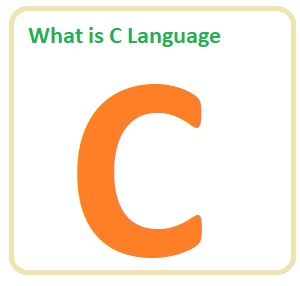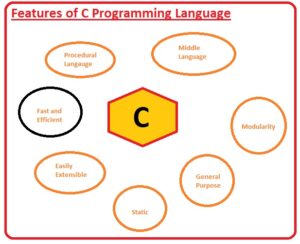 C is a general-purpose language technical computer programming language backup designed programming, lexical adjustable scope, and recursion, with a static kind system. By project, C offers concepts that chart professionally to typical mechanism orders.
C is a general-purpose language technical computer programming language backup designed programming, lexical adjustable scope, and recursion, with a static kind system. By project, C offers concepts that chart professionally to typical mechanism orders.
It has originated in permanent use in requests before oblique in assembly language. Such requests comprise functioning systems and numerous request software for computer designs that range from supercomputers to PLCs and embedded systems.
Introduction to C
It’s a good idea to discuss the basics of programming language even if you don’t intend for starting programming projects.
It is an open-source, high-level, general-purpose programming language that has a straightforward syntax that is easy to use, which makes it easy to use for non-programmers. The language C has tools for code optimization and is object-oriented.
It has a very succinct syntax and avoids special keywords for operating systems compatibility, safety, and simple convenience. The C language is not a huge development to master, and after you get used to it, it gets easier and more fun to use. C is a general-purpose language. That means that you’re not restricted to one type of variable: variables can be single, double, or mixed.
Using Variables in C
vLocal variables are the smaller units of objects in C, while global variables refer to the larger unit. Two identifiers can refer to the same local variable, even if it is declared with different types. Figure 1. Local and global variable examples in C Which language the variable is used in determines whether it is a local or global variable.
. Local variables are contained within the current function, while global variables refer to the whole C program. Generalized reference types In C, variables can be declared with either volatile or non-volatile types.
Data Types in C
Most C programmers spend most of their time coding in data types, such as integers and structures of arrays, because these types serve as the building blocks of computing. A hard disk, for instance, may store the number 1.1 as an integer in any form of storage medium. Contrarily, structures are used to organize data, especially the data utilized by operating systems, and they are in charge of enforcing the division of data from programming logic.
Structures are so-called because, like a three-dimensional puzzle, they contain a small and fixed number of items (e.g., an application server in the case of Linux).
Expressions and Operators in C
Statements that can be evaluated and lists that can be browsed to reach a function’s conclusion are the two main types of expressions found in C code. Take into account the program below: if (value > 10) sum += value; else, static int value = 0; static int sum = 0; Assume there is a “counter” variable that reflects the payment amount.
The sum variable is an array of 1000 numbers. The result of the program being printed is “42”, so the sum is 42. The sum is an array of numbers. The first line is the beginning of a loop. When the value of sum exceeds 10, it will be multiplied by 10. The 10 is denoted as “10x” in this case. Each time sum equals 10, sum will be multiplied by 10. Thus, the loop will end when sum is 42.
Structs in C
The struct keyword in C can be used to declare a value type called a struct.
. A struct consists of fields, and any data that it contains can be accessed as if it were a normal scalar (a single integer value) variable. The keyword “struct” is used for the interpretation of different types having more fields
The first argument passed to the struct declaration function determines the structure type of the declared structure. The user defines the field types here, and the structure is automatically built, thus the size of the structure is known at compile time.
However, the structure must be cast to a suitable type at runtime. You can declare the types of the structure and the variable members of the structure.
Arrays in C
With the help of arrays, you can logically interact with numbers, strings, and data files. Arrays give a way to arrange data.
The C standard library provides a number of arrays for types such as char, float, and double. Lists in C A list is a sorted list of integers.Other data types, such as characters, lists of strings, or strings of character, can also be included in lists.
For example, this C code will list the words of the English language: #include #include int main () { char d; std :: string cur = “I”; std :: cout << d << ” ” << cur << ” ” << cur << “”; } There are several ways to implement an array in C, including using structs, linked lists, and dynamic arrays.
Pointers in C
Pointers are a part of C, being almost as essential to programming in the language as the control flow constructs that power structured programming. In many other languages, pointers do not have well-defined semantics, or their semantics are poor, so programmers must make painstaking efforts to write programs that work correctly. That is not the case with C. Pointers have predictable semantics and range from a simple integer value to complex numbers, including floating-point. They are value types, and value types can be used for reference, move and copy. This means that pointers can be either dereferenced (shown as *), traversed (as in a scan or Deref ) and copied. A pointer can be used as an index to perform a simple range-finding operation such as the find-if-need-be operation (see Sect.
Structures and Unions in C
Structures are constructs that are more general than structs and are usually used for storing variable-sized data. A structure looks like a set of memory blocks that conform to the same internal structure, called a structure. These structures can be implemented in different ways and are a useful syntactic choice when the underlying structure of the data has some performance constraints. C structures can be associated with names to form a named structure. There are two ways of doing this. The first is to create a variable to hold a structure, and then use the structure to refer to the variable. The other way of doing this is to create a structure and use the name of the structure to refer to variables stored in the structure. Then use the name of the structure to reference variables.
Stacks, Queues, and Linked Lists
A stack is a data structure that allows a computer to store multiple values of the same type in memory (typically in short-lived locations) and move values from one location to another through the use of a pointer, a value that indicates where the next value to be stored is to be obtained. The stack is the fundamental structure for all programming languages supporting general-purpose computer programming. If you want to see a step-by-step illustration of how the stack is used in C, take a look at the following snippet: Here, in addition to the struct cdata element to store a stack of lists, we see a struct slice to hold the value “mixed”, a pointer to a function called passed as an argument, and a pointer to a function called a function returned by the function.
Conclusion
Through the various use cases, the C language has developed into a language that is suitable for a wide range of use cases and tasks. The syntax of the C language is more similar to BASIC, the original programming language, in which many of its constructs originated. Although the language has evolved over the years to keep up with the needs of the industry, it remains a good candidate for embedded systems that require multiple function calls per program entry. Rohit is a software architect at Marlin Command Inc., Pune, India.






